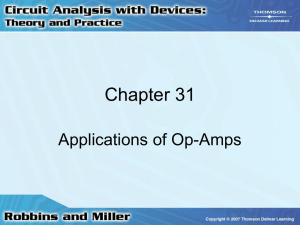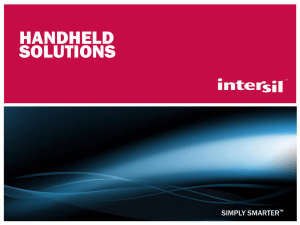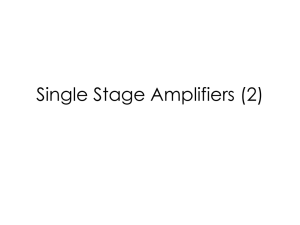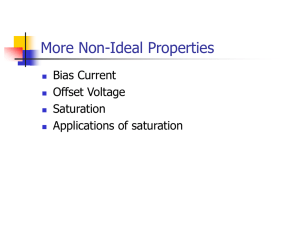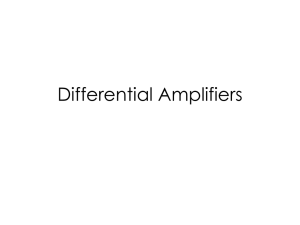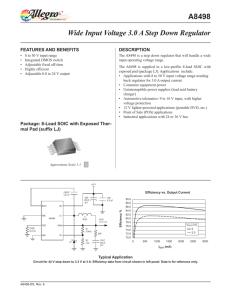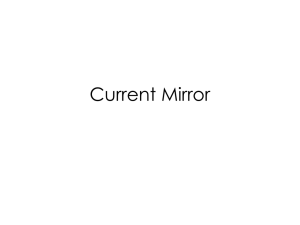Linear Regulator
advertisement
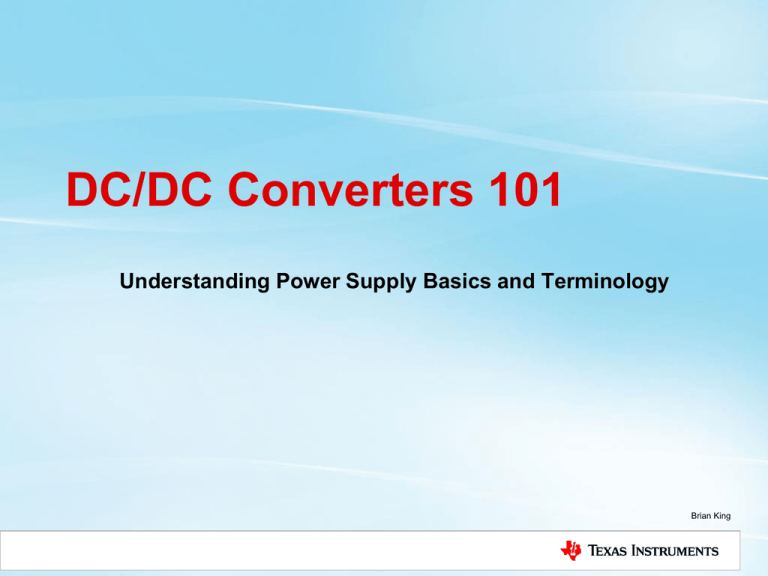
DC/DC Converters 101 Understanding Power Supply Basics and Terminology Brian King Agenda • Lecture • Overview • Linear Regulators • Switching Power Supplies • Topologies • Synchronous vs. Non-synchronous • Controller vs. Converter • Selecting the Best Power Solution Why should I care about power? 1. Every electronic system uses power. 2. Your power source never matches your system needs. Power Source What you need Typically 5V,12V or 24V 6.0Vdc-16Vdc 40Vdc Surge 3.0Vdc-4.2Vdc DC/DC Supply gets you from here to there 1.2V Core @ 2A 2.5V I/O @ 1.2A 3.3V 5V +/-12V 3 Linear Regulators vs. Switching Supplies • Linear Regulator – Pass element operates in the linear region – Down conversion only INPUT Filtering Filtering OUTPUT Pass Element(s) • Switching Power Supply – Pass elements switch, turning fully on/off each cycle – Filtering includes an inductor – Multiple topologies (Buck, Boost, Buck-boost…) 4 Linear Regulator ADVANTAGES: Low O/P ripple & noise Fast transient response Low cost (for low power, at least) Easy to design No EMI to worry about DISADVANTAGES: Low efficiency at VIN>>VOUT High dissipation (needs large heat-sink) VOUT<VIN – always! APPLICATIONS: Extremely low ripple & noise apps Low input to output voltage difference Tight regulation Fast transient response 5 Dropout Voltage • Dropout (headroom): The minimum required voltage across an LDO to maintain regulation + Vdo - Example: – Vin = 3.1V to 4.2V – Vout = 2.5V @ 100mA – Need at least 600mV headroom 6 Linear Regulator vs LDO • Linear Regulator has Higher Dropout Voltage. – Transistor or Darlington pair pass element – LM317 (1.5A linear regulator) • 1.5V to 2.5V dropout voltage • Good for larger Vin to Vout ratios, 12V to 5V output • CHEAP!!! • LDO = Low Dropout Regulator – Typically higher performance • PSRR, regulation tolerance, transient response, etc – MOSFET pass element – TPS72501 (1A LDO) • 170mV dropout voltage • Good for 3.3V to 3.0V output 7 Linear Regulator Power Dissipation Input Current = Output Current Efficiency P out P in V out I out V in I in V out V in Power Loss = Iout * (Vin – Vout) • Power loss is usually a limiting factor! 8 Linear Regulator vs Switcher 2.5W LDO + ground plane as heat sink 6W Switcher 9 Switcher DC VIN DC VOUT ADVANTAGES: High efficiency VOUT>=<VIN Wide input voltage range Low power dissipation (small heatsink) High Watt/cm2 Isolation possible (with transformer) Multiple O/Ps possible (with transformer) DISADVANTAGES: EMI Slower transient response More difficult to design Higher output ripple & noise APPLICATIONS: High efficiency power supplies High ambient temperatures Large input to output voltage difference Space constraints High output power 10 Basic Topologies Buck VIN VOUT V OUT D V IN Boost VIN V OUT V IN , VOUT V OUT VIN , V OUT Buck/Boost VIN VOUT VIN 1 D V OUT , V IN , V OUT D V IN 1 D 11 Synchronous vs Non Sync Non-Synchronous Buck Non-synchronous L Q1 D1 C0 Synchronous Buck Synchronous L Q1 Q2 1. Diode voltage drop is fairly constant with output current 2. Less efficient 3. Less expensive 4. Used with higher output voltages C0 1. MOSFET has lower voltage drop 2. More efficient 3. Requires additional control circuitry 4. Costs more 12 Synchronous vs Non Sync Vin=5V Vout=1V Iout=1A Rdson_sync=0.12ohm 1V Output Synchronous PFET_SYNC Iout PFET_SYNC 1A PFET_SYNC 0.096W 88% 2 1 D Rdson 0.8 0.12 2 Vf_diode=0.5V 1V Output Non-Synchronous Pdiode Idiode_avg Vdiode Pdiode ( 1 D) Iout 0.5V Pdiode 0.4W 69.4% Sync vs Non-sync is less of an issue with higher Vout Higher duty cycles = less power dissipation in Sync FET or Catch Diode 13 Synchronous vs Non Sync Power FET Synchronous FET 14 Synchronous vs Non Sync Integrated Power FETs Rectifier Diodes Integrated Power FET and synchronous FET 15 Controller vs Converter • Controller – – – – Discrete MOSFETs Provides the “brains” to control the power stage More complicated to design Full control over FET selection, switching frequency, overcurrent, compensation, softstart – Can tailor the power supply to meet your specific needs • Converter (Fully integrated) – – – – Integrated switches “plug and play” design Limited range of output filter components Limited control over functionality • Converter (Partially integrated) – – – – May offer full or partial feature set , internal or external compensation Internal Power FET, external sync-FET or catch diode Limited control over frequency, overcurrent, softstart, etc Allows wider range of output filter components 16 Converter (Fully Integrated) TPS62293 2.3V to 6V input 1A Output Current 2.25MHz Everything is integrated, minimum external components 17 Converter (Partially Integrated) TPS54620 4.5V to 17V input 6A Output Current Internal FETs, external SoftStart, Compensation, Frequency set… more flexibility Set frequency Compensation 18 Controller TPS40303/4/5 3V to 20V input 10A Output Current 300kHz to 1.2MHz External FETs Compensation Softstart Current limit 19 Size vs. Cost vs. Efficiency Efficiency Cost Synchronous Non-synchronous Linear Regulator Power Density Cost Converter (Fully Integrated) Converter (Partially Integrated) Controller 20 Efficiency vs Vout • Efficiency depends on output voltage? The datasheet says: • Why isn’t MY supply 95% efficient? 21 Efficiency vs Vout Simplified power dissipation equations assuming no inductor current ripple 3.3V Output 1V Output Power FET Conduction Losses Sync FET Conduction Losses Total FET Losses 0.173 W 0.136 W (does not include other circuit losses) 22 Efficiency vs Vout 3.3V Output 1V Output T P S 6 2 4 0 0 E ffic ie n c y v s Vo u t (Vin =5 V,Io u t=3 0 0 m A ) 9 4 .5 94 E ffic ie n c y (% ) 9 3 .5 93 9 2 .5 92 9 1 .5 91 9 0 .5 90 8 9 .5 1 .5 2 2 .5 3 3 .5 Vo u t (V) 23 PWM vs PFM • Pulse Width Modulation – Constant frequency – Low output voltage ripple – Used with high output currents • Pulse Frequency Modulation – Varying frequency with Vin and load – Very high efficiency at very light loads – Higher output voltage ripple – Potential operation in audio range 24 PWM vs PFM 100 90 PFM mode VO U T 2 = 1 .8 V 80 V IN = 2 .7 V E ffic ie n c y (% ) 70 60 50 V IN = 3 .6 V V IN = 5 .0 V VIN = 2 .7 V P o w e r-S a v e M o d e (P S M ) VIN = 3 .6 V 40 VIN = 5 .0 V 30 PWM mode F o rc e d P W M M o d e 20 10 0 0 .1 1 10 100 1000 L o a d C u rre n t, I O U T (m A ) 25 Startup - Softstart – – – – Slowly turning on the power supply Controlled rise of output voltage Minimizes inrush currents Minimizes system level voltage drops • Pulling high currents out of input bus • High impedance batteries – Internal vs SS capacitor • Larger SS capacitor = longer softstart time 26 Startup - Sequencing • Sequencing – Controlling the order that different power supplies are turned on – Important for uP loads – Minimizing overall inrush current Sequential sequencing 27 Startup - Sequencing • Ratiometric Sequencing • Simultaneous Sequencing 28 Easy Answers – Power Quick Search • Provides a list of possible linear regulators, controllers and converters based on inputs • Great starting point for selecting a device 29 Easy Answers – Power Quick Search 30 More Answers – Browse The Product Tree 31 Easy (Simulated) Answers – WEBench • Provides a complete design based on inputs • Best for customers with little or no power background 32 Easy (Real) Answers – TI Designs/PowerLAB • Searches reference designs based on input 33 THANKS!! Questions??? ufseniordesignanaloghelp@list.ti.com 34


